This is an in-depth review of Ark Nova, one of the highest-rated board games from 2021. But can it also get on the list of all-time greats?
Introduction to Ark Nova Board Game Review
Visiting a zoo remains one of the finest childhood memories for many of us. It’s something magical seeing exotic animals for the first time. Tall giraffes, powerful bears, mighty lions, venomous snakes …
But even as adults, it’s fantastic to study mother Nature’s ingeniousness and originality of its designs. I’ve been recently and even I, not too much of an animal person, was deeply impressed by the colorfulness of a parrot or the killing capacity of a tiger.
Therefore it’s no wonder animals and zoos are a popular theme in gaming. Particularly in video gaming, with its many theme park games. But also in board gaming. New York Zoo, Bärenpark, and Wingspan pop to mind, but I’m sure there are many more.
But normally, board games follow a very tight set of rules, making the games feel more like an optimization puzzle than a sandbox. It wasn’t until Ark Nova that a board game caught that liberal do-what-you-like feeling. Of course, there are still limitations, but never before were you given a chance to build your custom tabletop zoo.
Ark Nova Facts
Published: 2021
Designer: Mathias Wigge
Illustrations: Loïc Billiau, Dennis Lohausen,
Graphic design: Steffen Bieker, Christof Tisch
Genre: hand management, tableau-building
Playing time: 90-180 minutes
Players: 1-4, best at 2
Complexity: medium-heavy
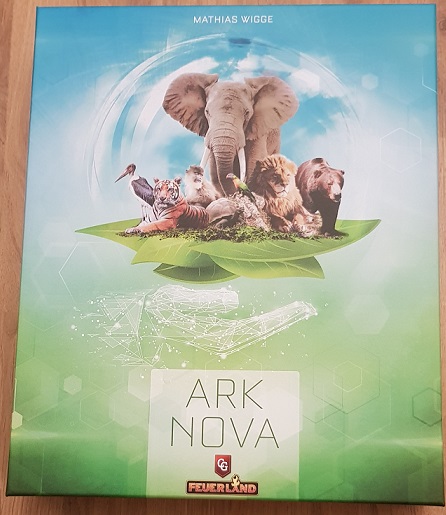
The theme is one of Ark Nova’s strength
In Ark Nova, you’re building your own zoo. This means that you must construct pens, fill them with animals, help with conservation projects, and also take care of the financial side of the business.
The theme is a major selling point of the game and it does come through superbly. If you want to add an animal to your zoo, each one has its own prerequisites. A pen of a certain size, perhaps connected to water or rocks. Then comes the monetary and administrative part (perhaps you need an affiliation with a certain continent’s zoo).
All of these characteristics make the animals feel unique and valuable addition to your zoo. Even more so, because most animals also come with a one-time special ability that can boost your progress. Adding animals is therefore an enjoyable and satisfying activity, which makes you feel like you’re really building something.
Once you have a certain set of animals (perhaps several primates, several European animals, etc), you can initiate a conservation project. These are your contributions to preserving animals and their natural habitats.
The ultimate thematic conservation project is releasing an animal into the wild. In this case, the animal is removed from your zoo, its pen is freed up, and you’re rewarded with a nice sum of conservation points. And the animal is rewarded with its freedom.
Artwork and Graphical Design
The graphical design is clean, colorful, and easy to read. As are the cards and the iconography. Moreover, the explanation of icons and cards is available in the rulebook appendix. Therefore, once you learn the basics, Ark Nova requires very few gameplay interruptions to check on rules.
There aren’t many illustrations as such. The cards carry slightly stylized stock photos, which has caused a small divide in the community. I personally liked the more realistic approach. Primarily, since there are many animals included that most of us haven’t even heard of, it’s nice to see how they actually look, and not how the artists think they look.
This goes hand in hand with the educational aspect of the game. You will learn about animals in Ark Nova. This is inevitable, even if you don’t want to. Latin names are included, as are the animal categories used in the game. While these have been slightly altered for better gameplay (you’ve got herbivores, predators, small animals, reptiles, birds, primates, and bears), they are close enough to reality to tick both realism and gameplay boxes.
Why is Ark Nova so Popular? – 5 Reasons
Components
Ark Nova falls into the classic-component category. This means no fancy miniatures, just cardboard, cards, and wooden markers. But that’s no bad thing. The overall quality is relatively high and the components are a joy to handle.
How do I organize my Ark Nova?
But the real stars are the two plastic trays (just like in A Feast for Odin). Ark Nova comes with many pen tiles, coins, and other markers and the trays help keep the setup and teardown to a minimum. Frankly, I want these in every component-heavy game from now on. And I won’t take no for an answer!
While the rulebook does not provide a suggestion on how to organize your components in those trays, with access to the internet, you can find solutions rapidly. You can use my layout pictured below (which I stole from someone else anyway). Or play a game or two and decide on a layout that suits you the best.
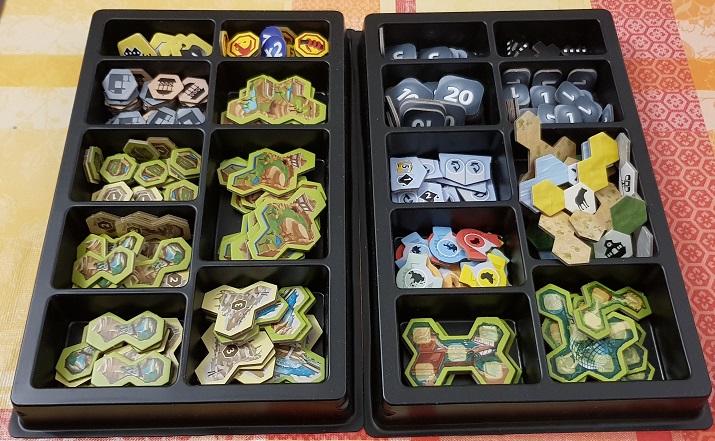
How many cards are in Ark Nova?
Obviously, Ark Nova is built around cards. And there’s a large number of them, almost an absurd number – a total of 255 cards are in the game. 11 Scoring cards, 12 Base Conservation cards, and 20 double-sided Action cards (5 per player) are there only as support.
It’s all about that Zoo deck, though. 212 cards in total:
- 128 Animal cards,
- 64 Sponsor cards,
- 20 Conservation projects.
The number of cards guarantees diversity – you’ll meet new animal cards for several games to come. This is positive from a thematic and educational point of view but having that many cards comes with its drawbacks. More on that later.
What sleeve size do I need for Ark Nova?
The cards are standard-sized, 63x88mm (2.5 x 3.5 inches for you, nonmetric pals), so getting proper sleeves for them should be no problem. Should you sleeve them at all is another question, which only you can answer. Due to the high number of cards, it can get expensive. However, it does help with protection when shuffling since you have to mesh-shuffle if you want to properly mix a deck of this size.
Learning Ark Nova
As is quite the norm with Feuerland Spiele, the rulebook is excellent. The game itself has a remarkably elegant structure, so the rulebook is also straightforward in design. It’s focused on actions, described in detail, together with illustrations and examples.
I particularly liked that it’s not written in a strictly technical manner, but addresses the reader in a more friendly tone, including reiterations and further clarifications.
There’s a Glossary attached, which further clarifies individual concepts and animal abilities. This is a bit more technical and is meant to be used as a reference during the game. As is the accompanying sponsor cards clarification list. Although these cards have a clear iconography on them (you won’t need a reference list after a bit of experience), this list will be more than welcome during the first couple of games.
To conclude, the rulebooks do a great job of teaching you to play Ark Nova. Yes, the initial reading is 20 pages long, but the reading is not too heavy and is interrupted with colorful examples. Since the basic concept of the game (5 actions) is simple, it won’t take you more than one read before you can play. After that, only a quick reference here and there is needed.
Setup
Thanks to the two plastic trays for components, the setup and teardown are both surprisingly fast. Perhaps the single most tedious job is shuffling that 212-card thick deck.
In the beginning, you draw 8 cards, out of which you select 4 as your starting hand. I found this to be sufficient to find something useful, but I’ve seen people seeing this as not enough selection. You can always house rule this towards more choice (using drafting or mulligan). It’s something to keep in mind as an option, particularly if you wish to play in a more casual manner.
It’s worth mentioning that the game requires a large table to play, even with 1 or 2 players. This is mainly down to the very large central board, particularly in one dimension (it’s too long, frankly).
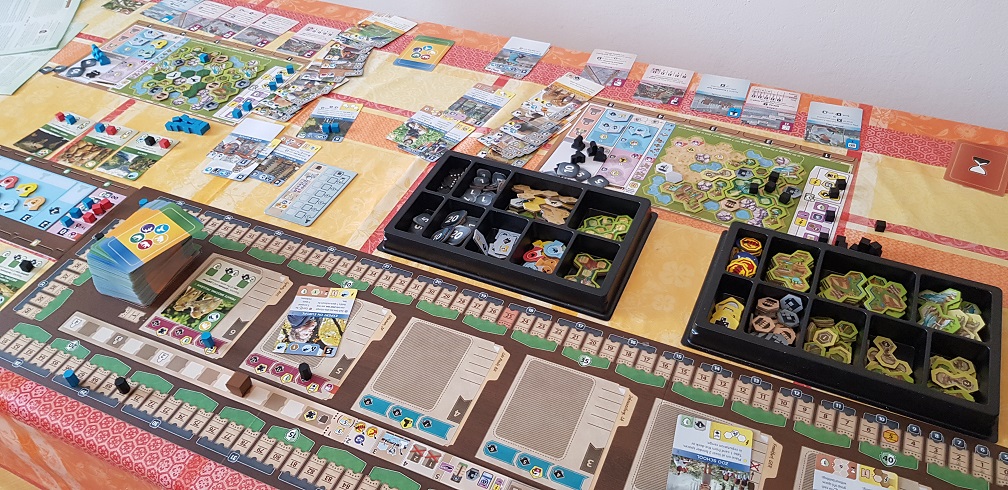
How to play Ark Nova?
There are two main attributes that determine how successful your zoo is. First is the appeal, which you increase by adding animals. The second is conservation, which you increase by supporting appropriate conservation projects (for which you must first fulfill conditions).
Both markers start at the opposite side of the track and when the first player makes the markers meet, the end-game is triggered. This makes Ark Nova a race and its playing time is heavily dependent on the ability of the best player. If you played Rajas of the Ganges, which uses similar victory conditions, you’ll know exactly how this works.
So, you need to build pens, keep your income high, add animals, associate with other zoos, appease sponsors, support conservation projects, take care of your reputation, and much more. So how is this driven?
Action selection mechanism
Here comes the Ark Nova’s elegance. Each turn you will select just one of five available actions, depicted on your action cards below your board. The trick is the further right the card is, the stronger its action. After it is used, the card is moved to the far left position, and every other card is slid to the right. (the most notable game that used this mechanism is Civilization: A New Dawn)
This creates a very interesting optimization puzzle, where you’re juggling usage of the cards in a specific order – to do the actions that need to be done, to get the cards in the right spot at the right time, and to utilize their full potential. Moreover, cards can also be upgraded, making their ability even more potent.
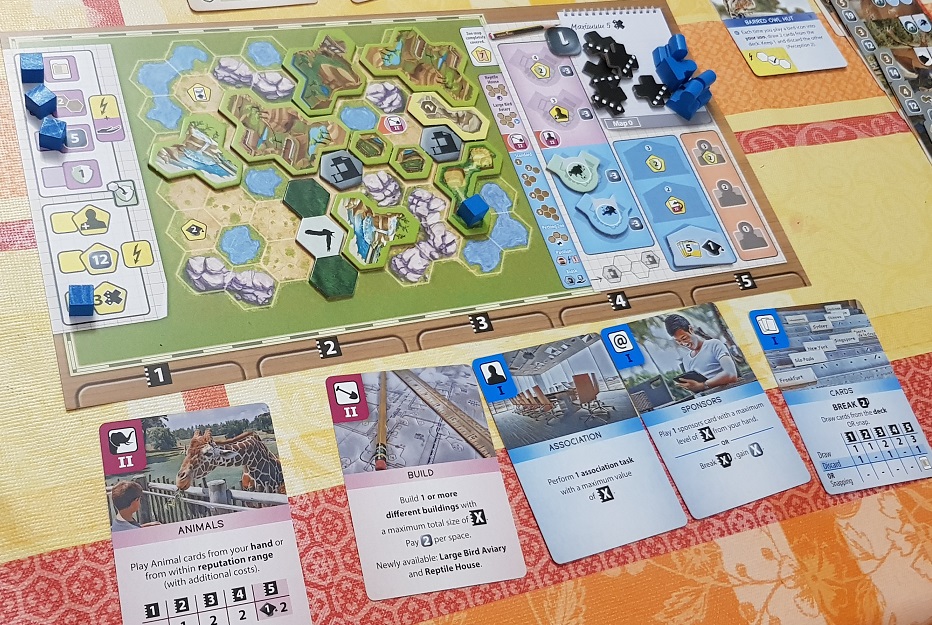
Let’s take a look at the actions:
- Cards action allows you to draw more cards – either from the deck or from the display (your reputation comes into play here).
- Build action lets you build more pens on your zoo map. Certain rules apply here; you have to build adjacent to already existing pens and you receive instant bonuses if you cover them.
- Animals action is how you place your animals (from your hand) into the appropriate pen. Of course, you can only do that if you can afford it and if you fulfill all the other requirements depicted on the animal card. You receive the appeal and the card effect immediately.
- Association action lets you place your workers on the association board. This is a mini worker-placement game. Possible actions (dependant, of course, on the position of the action card) are: to increase your reputation, associate with other zoos and universities, and as the strongest action, support conservation projects. Either you place one from your hand and support it immediately or you support one of the projects already on the board.
- Sponsors action is the way you can play sponsor cards from your hand. These cards give you unique buildings, one-time or ongoing abilities, and even end-game bonus points. You can also use this action to get a bit of extra cash.
Ark Nova: Which action cards to upgrade?
There’s no rigid turn or round structure in place. Certain actions move the break marker (if you draw extra cards or take extra money), and when this marker moves all the way down, there’s a brief upkeep phase and players get their income. After that, it’s back to players’ actions as usual.
And this is basically how the whole game goes. Players select one action card, perform its action, move the card to the left, and it’s the next player’s turn. Until one of the players fulfills the end-game goal – making their appeal and conservation marker meet.
How do I teach Ark Nova to new players?
The aforementioned elegance of Ark Nova makes it a breeze to teach. You start with the game idea and victory conditions, and then you can go straight to the actions.
The gameplay is intuitive – everyone will instantly understand that for a zoo to work, you need animals in it. And you need to build some sort of pens for those animals.
Although the game has plenty of quirks beyond these basic concepts (how actions relate, the bonuses you can acquire, the synergies, and so on), you don’t need to bother with details. They are not needed to be known at the start of the game. Fill them in as you play.
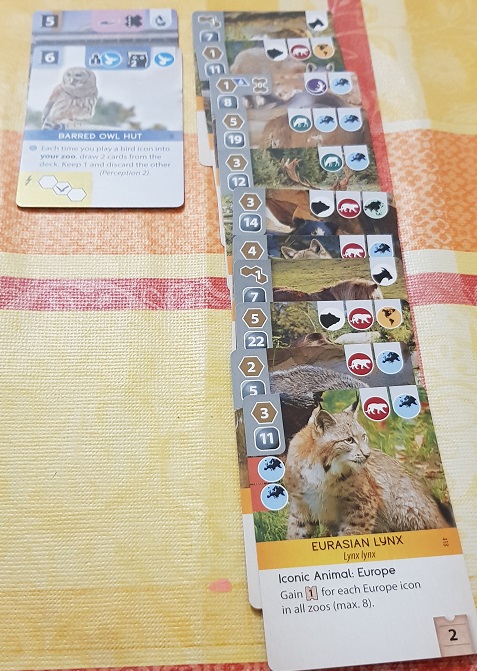
How does Ark Nova work in practice? – Gameplay Impressions
Because the game uses a player-triggered end-game condition, you don’t feel too much pressure to complete certain tasks in due time. This results in a laid-back, almost sandbox-y nature of play.
Tinkering with your zoo, building the pens just the way you like them, placing a kiosk here and there between them, and then filling everything with animals that will synergetically complete a conservation level is very satisfying. Looking at the zoo in front of you and all the animal cards in it makes you feel like you’ve accomplished something. If you played any of the tycoon video games and looked in awe at your empire, Ark Nova is the closest you can get to that in board gaming.
The mechanics behind this are another reason why the process is so enjoyable. The action selection is just brilliant. So challenging, yet so deviously simple. If you want to get close to optimal play, there are a lot of factors to consider when choosing an action card.
Taking everything into account
Normally, you want to go in order of building a pen and then fill it with an animal from your hand. But what sized pen does the animal need? Does it have to be near rocks or water? Remember, the further right the Build card is, the larger the pen you can build. And don’t forget about the bonuses you can get from your map. These can really boost your progress, particularly in the early phases.
You need to also consider the cards on display. Is there something useful you should draw to your hand first? With the upgraded animal action card, you can even fill the pens with animals directly from the display.
The animals themselves deliver many benefits. Not only do they provide valuable appeal, animal type, and continent icons, but you can also use their abilities to chain more actions together.
And this is just the basic pen-animal action chain. There are universities that provide extra icons and upgrades, associated zoos, also providing actions and discounts, sponsor cards with all sorts of useful abilities, conservation cards for those juicy conservation points, X-tokens to increase the strength of action cards, and so on.
Ark Nova is an elegant and highly enjoyable blend of mechanisms with an excellent theme implementation.
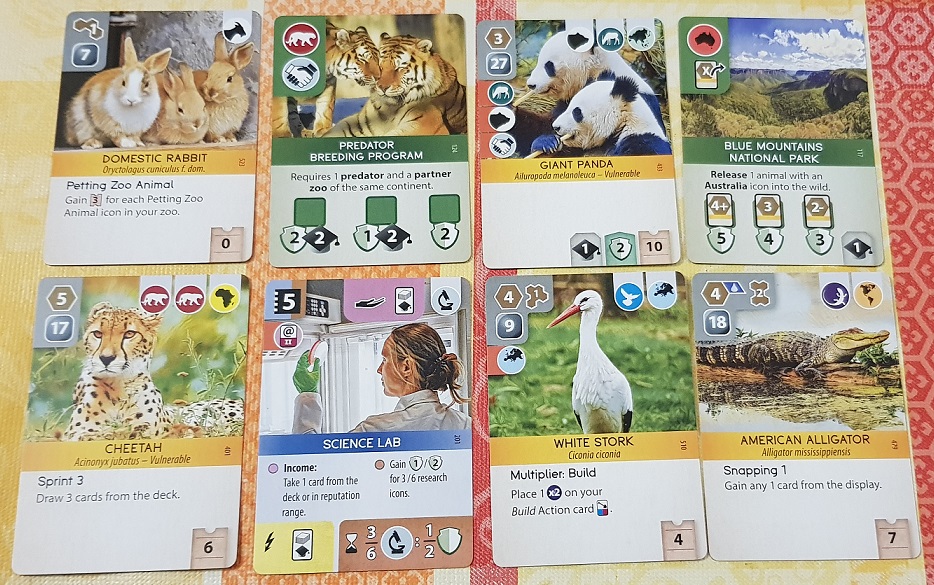
Replay Value
Since there are a lot of cards in Ark Nova, you can’t rely on a single strategy. Every game, new cards will appear and you’ll only get through half the deck in a typical 2-player game. There are also different map layouts – from beginner maps that offer plenty of bonuses, to more advanced, and finally, asymmetrical maps. Here, every layout has a different ability that allows your playstyle to be unique.
This combined guarantees a high replay value – you’re always curious about what tools the game will give you this time and how to best combine them into a winning strategy. This is particularly true for the first couple of dozen plays when every game will introduce not yet seen cards.
Long-Term Appeal of Ark Nova
While this drags you back to the table, again and again, the long-term appeal is somewhat questionable. Now, the large volume of cards is actually working against it.
The large deck and the dependence of the game on it, inevitably means you’re at the mercy of it, there’s just no way around that. This renders the game to be somewhat more tactical (you react to a current situation) rather than something you can develop a strategy lasting the entire game.
If you’re aiming for that fifth bird icon to complete a conservation project and no birds come out of the deck, there’s not much you can do. Sure, you can keep drawing, but that is most likely just a waste of actions and you’d be better off if you went for something that is actually available.
This also detracts from immersion, from the thematic sandbox experience. More often than not, building the zoo of your dreams won’t be possible, because that Siberian tiger that you wanted didn’t even come out of the deck this game.
Don’t get me wrong, the game is still positively pleasant and the high random factor didn’t pose too much of a problem for me. You just have to accept that sometimes you’ll get what you need, and sometimes you won’t.
But it might be the reason why Ark Nova won’t become one of the all-time greats, but “only” an exceptionally good game. There are just too many factors left at the mercy of the draw, and sometimes you’ll have no chance of winning (particularly in solo mode, more on that below).
Discovering the Depths: Ark Nova Marine Worlds Expansion Review
Is there much interactivity between players in Ark Nova?
There isn’t much player interactivity in Ark Nova. You are mostly focused on your own zoo and actions. Although some animals have direct take-that abilities, these don’t make much thematic sense and are rare, so usually, they don’t come into play at all.
Players mostly interact when competing for the cards on display and especially the conservation projects. These can only hold a limited amount of markers, so if two players are collecting herbivore icons, things will get interesting on that conservation project card.
Scalability and Playing Time
Although the gameplay scales from 2-4 players comfortably, the concern is the long playing time. Even with only two players, you’re looking at roughly two hours. OK, you can get that down once you know what you’re doing and accumulate points faster. But even in an ideal scenario, it takes 90 minutes for 2 players and up to 3 hours for a full 4 player game.
Ark Nova is basically the main event of the board gaming evening or even the only event of the evening. But since the 3rd and 4th players don’t add anything to the gameplay (other than the increased playtime), I prefer Ark Nova in 2-player format and this is the number it performs the best at.
If I can be even more specific, everything points in the direction that Ark Nova is aimed at gaming couples. Low player interactivity, semi-casual approach (competitiveness not emphasized), a theme that appeals to women … A cozy winter evening with the two of you sipping tea, minding your own zoo. Bliss.
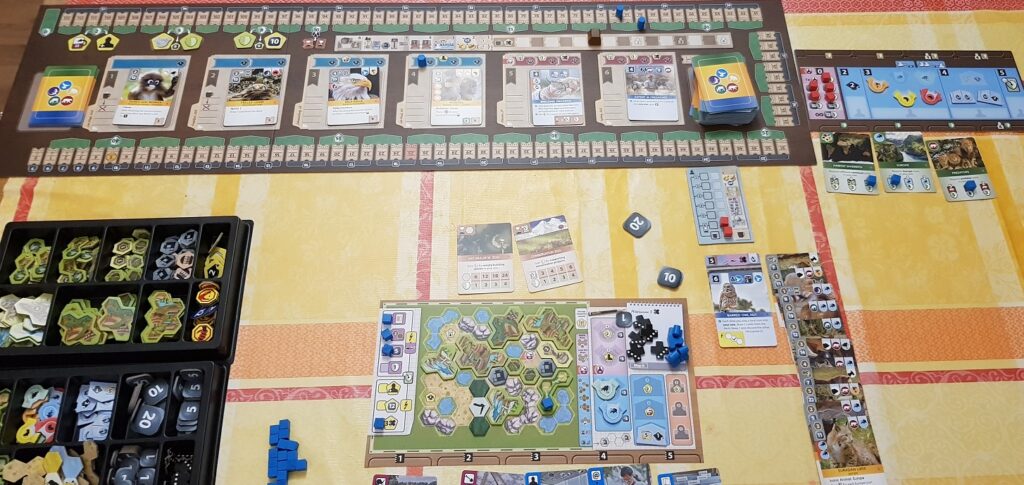
Ark Nova Solo Review
Ark Nova does feature a fully-fledged solo mode. Although the rules are pretty much identical to the multiplayer version, there are substantial gameplay differences. First, the game lasts for a hard-capped number of turns. If you can make your markers meet by that time, you win (you can adjust the difficulty with how many points you start with). Second, the breaks are also not player-triggered but occur at predetermined times.
The result of this is that the game feels different. It loses its sandbox nature since you now have to focus on optimizing the available resources even more, instead of being allowed to do what you like. The fixed breaks also tie your hands, income-wise. While you’re struggling with money at the beginning, in later rounds, you’ll be swimming in cash.
But the main problem is that the card draw is even more problematic in solo mode. Your success is directly dependent on a favorable draw (particularly conservation projects), and unfortunately, it’s too often that this draw decides the outcome of the game, not your actions.
Other than that, the solo mode is low maintenance and the gameplay is fast. You can squeeze a game into an hour, and if nothing else, is a great tool to learn and practice.
ARNO – a much-needed and recommended alternative – a fan-made solo bot
Conclusion – Is Ark Nova a good game?
Ark Nova is a remarkably good game and certainly up there with the best games of 2021 – if not even in the first place. The feel of building a zoo is wonderfully implemented, and the action-selection mechanism is perfectly interwoven with supporting mechanics.
It’s not without its faults, though. It’s long, and you’ll often be praying to the Random gods for a favorable card draw.
But the flaws are far too small to deter me from enjoying this gem. While I don’t know how it will stand the test of time (although it certainly looks rather solid up there at the all-time BGG rankings), I don’t really care as long as I’m enjoying playing it. And I’m enjoying it immensely.
>>>Ark Nova is available on Amazon<<<
If you click on an affiliate link, it will take you to the Amazon store. If you then buy something, I will earn a commission – I am a member of the Amazon Associates program, as well as others.
Do you like what you just read? Consider subscribing for more content:

